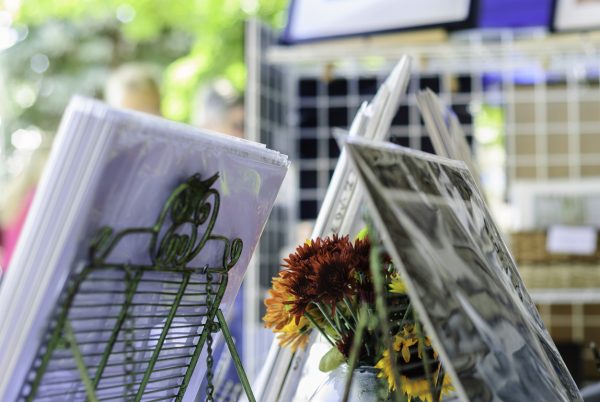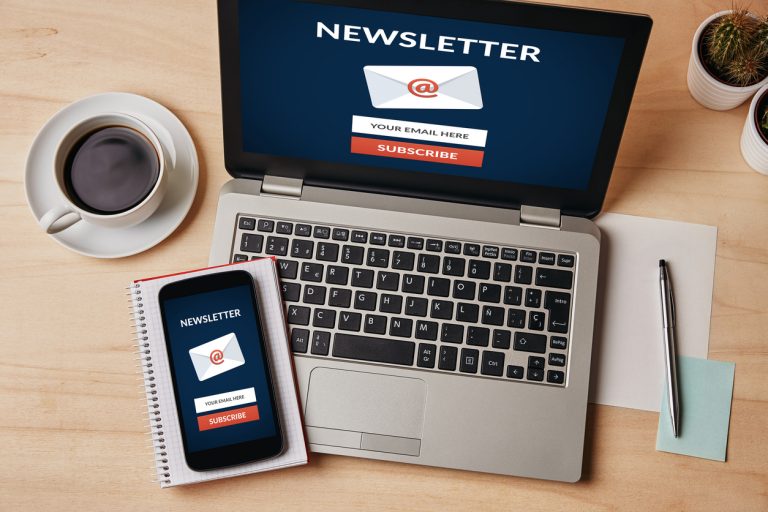If you’ve ever heard a potential customer say they love your work but they’re unable to make a purchase right now, signing them up to your newsletter is a great way to keep in touch, secure future sales, and build up a following along the way. A newsletter can be a secret weapon for artists looking to engage with their client base on a more personal level. They’re a tool for connection, offering a behind-the-scenes glimpse into your creative process. So, should you start a newsletter? And how do you go about it? This simple guide explains it all.

What are the benefits of starting a newsletter?
We all know the importance of maintaining an online presence, but what can a newsletter do for you that Instagram cannot? With social media algorithms changing all the time, newsletters provide a way to communicate directly with your followers, giving your content the best chance of being seen. You’ll be able to provide extra value for your clients, and foster a feeling of exclusivity – it can be the personal touch that sets you apart from the crowd. What’s more, it can be a fantastic tool for increasing commissions and sales, acting as a friendly reminder of your services.
Should I start a newsletter?
Newsletters are ideal for those looking for some extra promotional help. However, they can be time-consuming to create, and their success is subject to a consistent mailing schedule. If you already find yourself swamped with commission requests and unable to take on an extra responsibility, it’s better to shelve the idea until your schedule clears up. But if you have some free time (or delegate the task to your assistant) and would like to increase your visibility, a newsletter could be for you!
How can I gain subscribers?
Getting consent from your subscribers is paramount, and only those who have given permission to be contacted should be receiving your newsletter. Start by approaching those closest to you, and bring a sign-up sheet with you to fairs, exhibitions or markets. Ask those you engage with if they’d like to receive updates on your work, and let them know what they can expect.

Another popular way to encourage sign-ups is by embedding an opt-in form on your website. Most newsletter software will provide a HTML code which you can paste into the body of your website.
For more ideas, check out these tips for growing your mailing list and professional network.
Naturally, building your subscribers list takes time, but with consistency and effort, you’ll have a full house in no time.
Which email marketing software should I use?
There are a host of different programs you can use to get started. Mailchimp and TinyLetter are two of the most popular options for small businesses, providing a free service for those with less than 2,000 and 5,000 subscribers, respectively. With a clean, easy interface that requires zero technical ability, TinyLetter is perfect for those seeking simplicity. Mailchimp, on the other hand, boasts over 300 integrations, making it a preferable option for those looking to personalise every aspect, and learn more about their audiences wants and needs. Of course, there is no right software to use, it all depends on which tools you require, so it can be worth exploring a couple of different models to find out which one feels right for you.
What should I include in my artist newsletter?
Whilst newsletters are a great way to increase sales, come off too dull or sales-orientated and you risk driving people away. It’s important to strike a balance, and as useful as a newsletter can be to your marketing plan, it should also be about giving something back to your supporters. Think about who they consist of, their interests and habits, and keep this in mind when creating your content. Share updates on your work, or blend inspirations, personal stories and thoughts. Either way, keep it interesting by using a variety of media: pictures, GIFS, videos and links. Your content should encourage your audience to identify with you on a more personal level, but try to stick to one topic per post so as not to overwhelm them. Most importantly, be yourself, and experiment with different forms of content to see what resonates with your audience. Below are some ideas to get you started:
- Photos of works-in-progress.
- Snaps of your studio space.
- Reflections on artwork that has moved you or an exhibition review.
- Information on upcoming events.
- Lists! Playlists, to-do lists, best-of lists, etc.
- Giveaways and exclusive offers (for example, a free print to the person who submits the best title for your new painting, or 10% off for subscribers).
- Practical and technical advice on creative topics.
For inspiration, sign up for the ArtWeb newsletter or check out other successful artists you admire to see what they include.
How often should I send an newsletter?
Generally, newsletters should be sent no more than twice a week and no fewer than once a month. Again, it’s all about balance – send too often, and your emails will start to feel like spam, but send too infrequently, and your subscribers will forget who you are. My advice on this would be quality over quantity. Sending one engaging, well-made newsletter a month is bound to yield better long-term results than a hurried, insubstantial weekly one.
General tips for starting an artist newsletter
Do
– Be yourself!
– Be generous with your content and provide value for your subscribers.
– Use a variety of forms and media – videos, graphics, images, lists!
– Stick to one topic per post.
– Email consistently, at least once a month.
– Share behind-the-scenes insights.
Don’t
– Overly focus on sales; it can be off-putting.
– Use a super formal tone.
– Be repetitive — change things up every month!
– Get discouraged or take unsubscribers personally.







